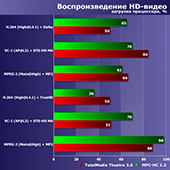
As we recently wrote in our review of six-core “twelve-threaded” processors, once top devices have been greatly devalued and practically forgotten due to the emergence of models for mass platforms with eight cores (and since last year, more of them). At the same time, quad-core processors “got” to an even greater extent, and in many ways even more undeservedly: just their long dominance within the successive LGA115x platforms made some particularly impatient citizens psychologically tired . Of course, with many tasks they both coped, and cope. Moreover, even dual-core processors are still selling well, which, however, have recently finally migrated to the budget segment – but many do not need anything else. What can we say about old computers and especially laptops that have not been changed for years according to the principle: “Does it work? Don’t touch!”
On the other hand, a faithful enthusiast from mentioning such processors should, if not fall down in horror and disgust, then at least wrinkle his nose and grumble: there are more cores in a mobile phone . Which is true – if you do not remember that the nuclei are different. Even within the same microarchitecture and one of its generations, laptop chips “squeezed by a heat pack” have always worked slower, consuming less energy than their desktop counterparts. In more complex cases, the differences only accumulate, so it is incorrect to automatically equate all processors with the same number of cores (even if they are similar). This is shown by their history – complex and interesting in its own way.
Rise and fall
Now it will sound funny, but in the 42 years of the existence of the x86 architecture, the issue of the number of cores, at least in some form, was discussed only in the last 15 years. not considered in general. The first attempts to create symmetric multiprocessor systems based on x86 date back to the late 80s, however, they were rather exotic specialized platforms based on i386/i486 (earlier 16-bit processors were not suitable for this in principle), which remained outside the sphere of interest of most PC users. . But when developing the Pentium, Intel initially laid down support for dual-processor configurations on a single board, which later “creeped” into the Pentium II / III – and many have already become familiar with such an implementation in practice. Actually, one of the most popular topics in 1998 was the use of Celeron in a dual-processor configuration.
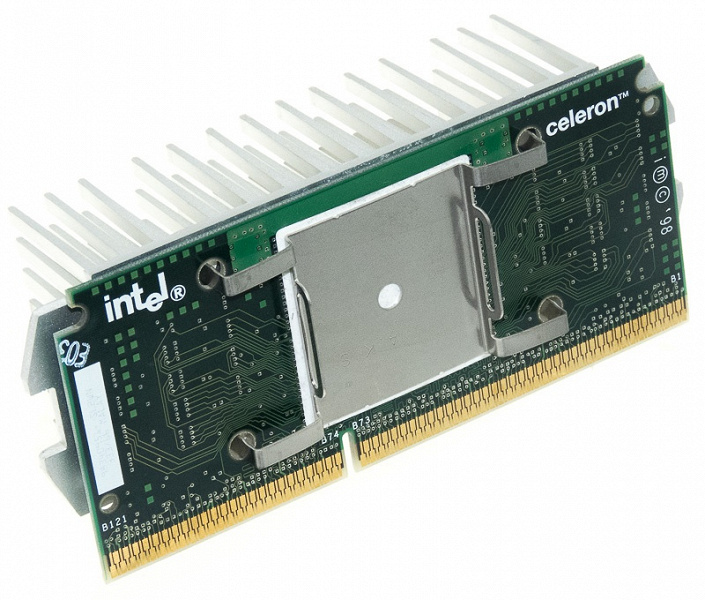
Why Celeron? Because these processors were very cheap at that time: they themselves cost some 200 dollars or less (this was the understanding of “cheap processors” then), boards with two Slot 1 “pulled” for the same couple of hundred (but this there was a level of “expensive boards” at one time), and getting it all to work together was relatively easy . Later, Celeron acquired L2 cache memory and began to work faster, and their transition from slot to socket execution made it unnecessary to modify the processor itself (more precisely, its board) – it was enough to buy a suitable adapter … A little more time passed, and some people picked up the baton motherboard manufacturers, releasing models originally designed for Dual Celeron . As a result, putting together a [relatively] inexpensive two-processor system was no more difficult than taking candy from a child.
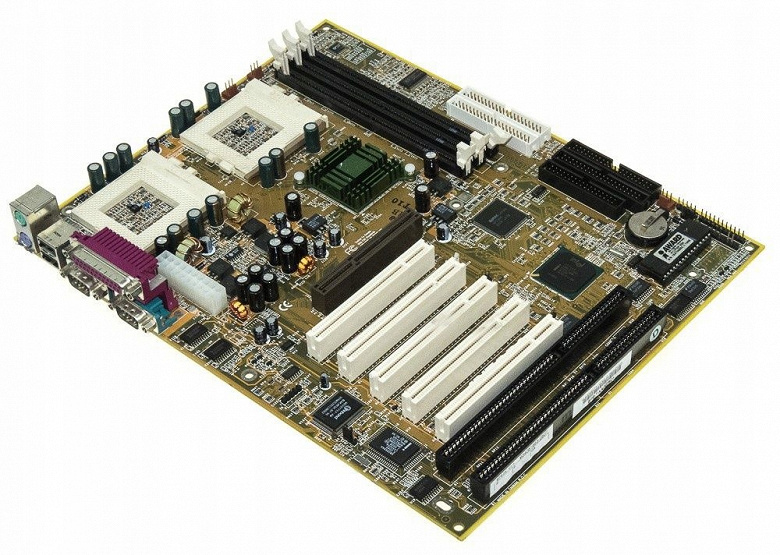
But dual-processor systems did not become permanent residents of the mass segment. In many ways – due to the fact that there were few application software oriented to such an application, and the mass operating systems of the Windows 9x line did not support multiprocessor. In addition, the “freebie” quickly ended: SMP support became the lot of extremely expensive Xeon and Athlon MP, and budget processors lost it (not only Celeron, but also junior Pentium III models – and then all Pentium 4). Some had some fun with the conversion of Athlon XP to Athlon MP, but it could not become mainstream. From the point of view of Intel, the future was then conceived as follows: for “serious” applications – the new IA64 (see Itanium), and in client computers it is supposed to remain exclusively 32-bit processors with a very long pipeline and huge clock frequencies (up to 10 GHz), capable of quickly grind one code stream.
The concept began to falter when it became clear that there would be no 10 GHz. Mass transition to Itanium – too. Fortunately, AMD took a different point of view: saying goodbye to x86 is not necessary, since it can be expanded to 64 bits and continue to be used in all segments, including HPC and other multiprocessor servers. But for this it was necessary to increase not only the number of processors in the system, but also the number of cores in each socket – which should have had a beneficial effect on personal computers and laptops. This is exactly what was done in 2005, when AMD Athlon 64 X2, Intel Pentium D and Core Duo appeared on the market. The first was obtained by combining two Athlon 64 cores in one chip – and with a common memory controller. It turned out not bad, albeit a little expensive: from $340 (however, at that time such prices still continued to be considered “normal”). And the Pentium D was actually a combination of two physical Pentium 4 chips under one cover. But the Pentium 4 by that time could hardly compete with the Athlon 64 – also due to problems with heat dissipation. As a result, such a frontal approach doubled all the problems, but the performance in applications optimized for multithreading did not quite double, since the younger Pentium D models had to be deprived of Hyper-Threading support. Hyper-Threading technology, of course, was not a full-fledged alternative to dual-core, but the Pentium 4 gave a certain speed boost. Meanwhile, in single-threaded applications (which at that time were the vast majority in everyday life and around it), processors with a “dual” organization (both Pentium D and Athlon 64 X2) did not have any advantages over their cheaper relatives at all.
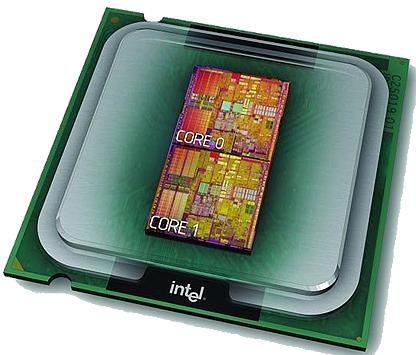
Notebook Core Duo was much more fortunate. These models also became the development of single-core Pentium M – but due to their deeper modernization. First of all, the use of a single second-level cache for a pair of cores has been added. It was not difficult for Intel to do this, since the company focused on inclusive caches – when each next level stores copies of the previous ones. AMD, on the other hand, used an exclusive architecture: if the data got into L1, then they are not in L2. For single-core processors, the exclusive architecture was more efficient, as it saved expensive cache space, but it made it difficult to use caches for inter-core exchange – a common level had to be introduced. Core Duo architecturally dated back to the Pentium Pro (albeit heavily modified), in addition to the mentioned cache, they had other advantages, and since the current NetBurst architecture at that time had reached a dead end, it was decided to release the successors of these processors to all markets. Which was done in 2006, when Core 2 Duo appeared – both desktop and laptop, and server. The big leap made it possible not only to catch up, but also radically overtake the Athlon line. AMD tried to start a price war, but Intel was better prepared for it, because this company was in the lead in the introduction of new technical processes and could easily produce a lot of chips – and cheaply. The result of the war, by the way, was the price levels so familiar to us: budget processor models (quite suitable for many applications) began to sell for almost $50, and 90% of purchases began to fall on the $80-$200 segment. Only a few buyers had to pay more – and only if they needed it for some reason. Compare with the end of the last century, when only obsolete processors for old platforms cost less than $200, and Celeron and similar solutions started from this mark. This is an excellent result and, from a consumer point of view, perhaps the most important result of the first decade of the new millennium.

But the technical results were different. The main thing is that the industry did not stop at two cores, because in the same 2006, not only Core 2 Duo appeared, but also a gluing of two such crystals in the form of Core 2 Quad. Glue bad? As a mass solution – to some extent, yes. As niche, it’s ok. The programmers have not yet fully figured out what to do with two cores, and for those who figured out, four were already ready. In 2008, rumors began to circulate about the “Core 2 Hex”, that is, a six-core processor made up of three Core 2 Duo for LGA775. We did not see such models, since their time has not come, but six-core Xeons appeared at the end of 2008. So after 27 years of fundamental single-core, it took only three or four years to introduce two, four, and even six cores! This is not just a big leap , but a fundamental change in the market.
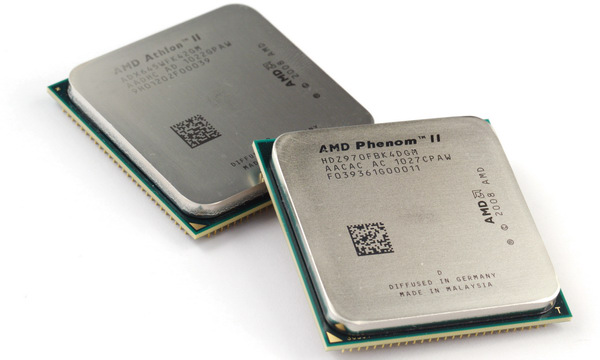
AMD, which developed the Phenom processors, also participated in it. In principle, these were the same Athlon 64, but with a shared L3 cache, which made it possible to release first four- and then six-core “monolithic” processors with this architecture. True, solidity didn’t really give much, but many characteristics of the new processors turned out to be worse than those of Core2. The only thing left to do was to fight with prices, including inflicting an unexpected flank attack: Athlon II X3 and X4 are the same Phenom II, but without L3. The younger processors were much slower, but very cheap: for the first time, quad-core processors appeared on the market at a price of $ 100 or even less.
With this baggage we arrived by 2010. Intel just switched from Core2 to Core: the new microarchitecture abandoned the dual-core design and allowed relatively free increase in the number of cores in the socket. True, the company used this only in the HEDT-solutions segment, where the number of cores in older models cheerfully increased from four to ten, and six-core models gradually fell in price from $ 400 to $400. Below were the mass platforms of the LGA115x line – and only four cores maximum. The first generation of Core, the second, third, fourth, fifth, sixth… During the development of the sixth (Skylake), there were rumors that these processors would become six-core – the 14 nm manufacturing process, in general, allowed. But this did not happen: both the desktop Skylake and the Kaby Lake that replaced them in 2017 remained quad-core. Tired! Yes, the processors themselves have become completely different: the performance of the same Core i7-7700K (Kaby Lake 2017) is three times higher than that of the Core i7-920 (the junior model for the LGA1366 of 2008, which cost the same as the tops for LGA115x ). There is no point in comparing the corresponding platforms. But the cores are the same. And all the changes (both processors and platforms) were evolutionary, that is, small at each step. From the time of the first generation, and the second and third, up to the seventh, they have accumulated in order. However, in comparison with the fourth – a little. And, we repeat, the main point was psychological: for almost ten years, quad-core Core i7 dominated the mass market. Different – but not perceived as fundamentally different. Fundamental changes had to be sought on other platforms, but also for completely different money: the ten-core Core i7-6950X itself cost more than one and a half thousand dollars, that is, more expensive than a good mass-series computer as a whole.
As a result, by 2017, a revolutionary situation had developed on the market – in strict accordance with the definition of grandfather Lenin: the top can no longer rule in the old way, and the bottom no longer wants to live in the old way. They would be overwhelmed, of course. But the soil was prepared and abundantly manured. And Ryzen fell on it – ensuring AMD’s triumphant return to the high performance segment.
Low-core Ryzen of the first series
As has been said more than once, initially AMD also developed a “core module” (CCX) of four processor cores with memory and PCIe controllers. But there was no point in entering the market only with this in 2017, since there were excellent and polished to a shine quad-core Core. Therefore, a crystal of two CCXs connected by an Infinity Fabric bus became a strategic product for the first time. On its basis, it was possible to make server solutions by combining several crystals with the same Infinity Fabric and getting 32 cores in one socket. Or you could just release a desktop Ryzen 7. Tests quickly showed that the Ryzen core of the first series was inferior to the latest Core, and the next gluing also interfered in some cases , but … But at that time Intel sold “8 cores / 16 threads” for 1000 dollars, a six-core was ready to “give away” for $400 (and these models were not the last Core), and four cores cost around $300. The eight-core Ryzen 7 retailed from $300 to $500 dollars, for which a lot could be forgiven for new processors. And they forgave.
But it was necessary to move in parallel towards a more mass segment, and it is always useful to dispose of marriage. A “complete” eight-core crystal was too complicated to make all copies perfect, and too expensive to throw away in case of minor defects. Therefore, Ryzen 5 appeared – with four and six cores. Why two lines at once? In the first generation, core shutdown could only be symmetrical, that is, if we have no more than one failed core per CCX, then we get a six-core Ryzen 5 1600 or 1600X. If at least one does not have two cores working, then the quad-core Ryzen 5 1500X. And the model with index 1400 allowed to dispose of crystals with partially non-working L3 cache. In general, a good housewife loses only cock crow . Such models, by definition, cost less than $ 300, and the younger representatives of the line – and less than 200. But the six-core Ryzen 5 in terms of performance could compete with the quad-core Core i7 (more expensive), despite the slower cores – there were more cores. And the quad-core Ryzen 5 looked fine against the background of the Core i5: the same number of cores, slightly slower, but dual-threaded. As a result, these processors quickly became very popular and, in fact, survived the “first generation” as such, since at the end they used not only “full-fledged crystals” (and not rejection), but even more recent Zen +.
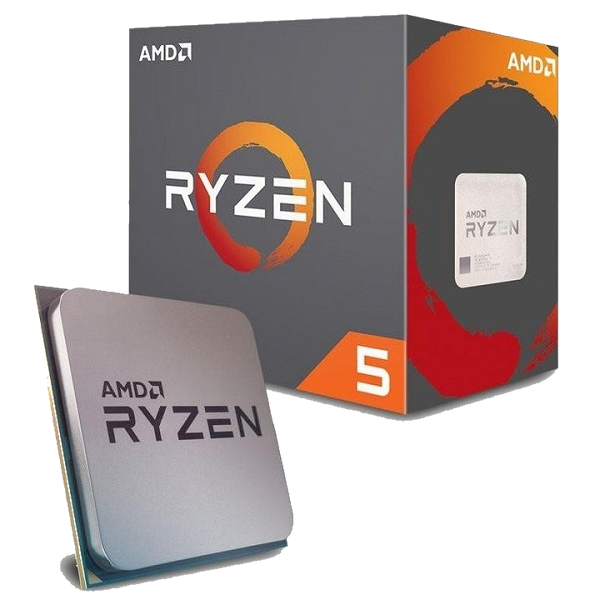
By the fall, Ryzen 3 1200 and 1300X appeared – in fact, Ryzen 5 1400, but with SMT disabled. This was already market segmentation in its purest form, since the likelihood of defects that prevent dual-streaming is extremely small. They were required as a temporary solution – before the advent of APUs, initially limited to four cores, but with graphics. At first, Ryzen 3 looked good, but they appeared a bit late – since the fall, Intel has been upgrading the platform. The new (officially incompatible with the old) version of LGA1151 has thrown cores into all lines. And it turned out that the six-core Core i7 can compete on equal terms with the older eight-core Ryzen 7 even when fully loaded (outperforming them when not fully loaded), the new six-core Core i5 is at least as good as the “old” Core i7, but costs like the “old” Core i5 , and the slightly lower quad-core Core i3 also replaced the “old” Core i5 at the price of the “old” Core i3. In principle, nothing terrible happened for AMD, it just had to reduce the prices of processors of all families. But under such conditions, just the cheapest ones ceased to be “interesting” – the surcharge to Ryzen 5 turned out to be too insignificant. The difference in price in practice was even less noticeable, because they were installed only in computers with a discrete graphics card: unlike Core, processors Ryzen families could not do without it.
But APUs were designed just for such use. They arrived in early 2018 and were, as expected, quad-core but with the most powerful integrated GPUs on the market. Of course, they were powerful only by the standards of integrated solutions, in fact, barely reaching the lower discrete, so they were not suitable for serious games (as well as the same lower discretes). And paired with a more or less powerful video card, the Ryzen 3 2200G looked strange in the presence of Ryzen 3 1200/1300X models, since it had less cache memory and PCIe x8 instead of PCIe x16. The Ryzen 5 2400G looked even weirder with the same limitations. In general, it was not possible to completely replace “clean” processors with such crystals.
When updating the lineup on Zen +, AMD still had to release the Ryzen 3 2300X and Ryzen 5 2500X, according to the numbers “built-in” just above the APU and just below the “adult” models (starting with the Ryzen 5 2600). They were intended for the needs of OEM assemblers and went to junior gaming computers, where a discrete video card was originally installed, so APUs would be out of place in them. But since the mass nature of such solutions was not required, AMD tried to make these models as fast as they could. For this, not a symmetrical shutdown of the cores in different CCXs was used, but a complete shutdown in the crystal of one of them. At the same time, the second CCX (which remained working) had to be perfect, without defects, that is, these processors were not suitable for scrap disposal. The marriage went to the AF-modifications of the Ryzen 3 1200 and Ryzen 5 1600 – also, in general, intended for the OEM market, although, as usual, they also went to retail. However, all these solutions did not gain much popularity, since Ryzen 5 2600 was too cheap and attractive, from the point of view of an individual buyer. And Ryzen 5 1600 leftovers looked even better. Those who were ready to limit themselves to four cores bought Core i3 – faster than Ryzen 3 (and at times even than younger Ryzen 5). In addition, Core i3 can do without a discrete graphics card – as well as Ryzen 3/5 APUs, which turn out to be a good choice for those who planned to limit themselves to integrated graphics, but faster than in Intel processors.
In general, by last year, AMD’s quad-core processors had become a thing in themselves. They were bought, but not particularly discussed. These already slow models found their place in computers due to their cheapness, but nothing more.
Ryzen 3000: the way to the people
At the time of the announcement, the new family of processors based on the new microarchitecture started with the Ryzen 5 3600, which is a great processor, but with an MSRP of $199. In principle, this is not so much, since the return of competition, as one would expect, has led to an increase in average prices for processors. But this is not so little, because the buyer always wants to pay less and get more. However, the role of budget models should have been performed by old Ryzen processors, which are available in warehouses in sufficient quantities. It even got to the point that deliveries of the Ryzen 5 2600 continued until the end of 2019: why rush to replace the popular model? Moreover, the new line differed from the old one not only in processor cores, but also in peripheral capabilities, however, it is impossible to use those on old boards, and there have been no new inexpensive boards until recently. Therefore, it was better to give the shops the opportunity to calmly sell the leftovers of old models than to arrange intra-company competition that no one needed. Even without that, some buyers had difficulties with the choice: the Ryzen 5 3600 in terms of performance is just about equal to the once top-end Ryzen 7 2700X, but many were confused by the fact that the second had as many as eight cores, and the first had only six. However, such an intersection of old and new lines was actually the only thing that could not be achieved with the “too early” release of new budget models.
The only expansion of the lineup occurred at the end of last year, when the Ryzen 5 3500 and 3500X were introduced in selected markets. The second, in fact, was a Ryzen 5 3600, but with multithreading disabled, and the first also had the capacity of the third level cache memory halved. Naturally, both were sold for less than $200: there is no need to talk about official recommended prices here, but real retail prices reached about $150. On the AMD website, these two processors are still missing and are unlikely to appear there (why – it will be clear a little later), but they are on sale and are unlikely to disappear soon. The reason for their appearance is clear: the “old” generation did not have very high gaming performance, although it competed well with the Core i5 in general tasks, and the Ryzen 5 3600 was more expensive – so it took to plug the hole. However, in any case, these were temporary solutions – for the period before the appearance of the main characters of today’s article.
The important thing here is, perhaps, the model number. Remember: Ryzen 5 1400 and 1500X are quad-core processors. In the Ryzen 2000 line, their counterparts can be considered APU Ryzen 5 2400G and “just a processor” Ryzen 5 2500X. And in the new Ryzen 5 3500 family, this is already six cores. A little lower is the APU refresh in the form of the Ryzen 5 3400G, which does not fundamentally differ from its ancestor. The numbers x300 and x200 in the old lines were reserved for Ryzen 3 – quad-core and quad-threaded. Now the x200 number is already “occupied” by the APU (Ryzen 3 3200G), and the Athlon 3000G supports the line of numbers from the bottom. In general, the company had only two free numbers left, 3100 and 3300, and logically, these should have been Ryzen 3 – traditional competitors for the Core i3. And those in the near future should receive support for Hyper-Threading and become analogues of the former Core i7-7700 and other similar processors. The new Ryzen 3s are coming out now, a little ahead of their Intel competitors, so they’re also quad-core and eight-threaded.
Previously, such a formula was reserved for Ryzen 5, and now it is Ryzen 3. But as we remember from the migration of Intel processors from one version of LGA1151 to another, the “nuclear formulas” 4C / 8T and 6C / 6T can provide approximately the same level of performance (with the same nuclei). In addition, the new Core i5 under LGA1200 expects the same operation as the Core i3: they will receive Hyper-Threading support and, therefore, will compete directly with the Ryzen 5 3600/3600X – but not with the Ryzen 5 3500/3500X. So, the latter have done their job and can leave. But the rest of the new processors are serious and for a long time to come.

Not surprisingly, AMD actually introduced not one line, but two (albeit one model in each). The Ryzen 3 3100 has become the “spiritual heir” of the Ryzen 5 1400: both CCXs work, but only half of their capabilities , that is, two out of four cores and half L3. This is not the best configuration in terms of performance, but it is ideal for scrap disposal. Such processors can be very cheap for the company, so their recommended price corresponds to the old junior Ryzen 3 … or Athlon II X4 600. In general, the return of popular quad -cores, but at a completely different level of technology: including support for PCIe 4.0, etc. Naturally , this requires the appropriate motherboards, so the B550 chipset (which we recently talked about in detail) is announced along with the new Ryzen 3.

The second new processor, Ryzen 3 3300X, is not as simple as the younger brother: one CCX works here, but in full form, with 16 MB of total L3. It has analogies with the Ryzen 5 2500X, but no less with Intel Core i7 processors until 2017. Recall that they have so far remained the best quad-core models on the market, since the cores themselves were slightly better than Zen / Zen +. But Zen2 is already in no way inferior to Core cores, or even superior. Thus, starting next month, the AMD AM4 and Intel LGA1200 platforms begin to bury all the old LGA115x versions in two hands and in all segments. The new Core i3 and, in particular, the new Ryzen 3 will also be a good temptation for those users who did not want to upgrade old platforms, because they considered four cores to be enough (especially when they already exist). Well, here are new better four cores for them inexpensively, complete with new peripherals, improved maintainability … And potential upgradeability, after all.
However, the main question is how it works in practice. So far, we cannot get acquainted with the LGA1200, but we can already appreciate the place in the life of the new Ryzen 3. What will we do.
Test participants
| AMD Ryzen 3 3100 | AMD Ryzen 3 3300X | AMD Ryzen 5 3400G | AMD Ryzen 5 3500 | AMD Ryzen 5 3600 | |
|---|---|---|---|---|---|
| Kernel name | matisse | matisse | Picasso | matisse | matisse |
| Production technology | 7/12 nm | 7/12 nm | 12 nm | 7/12 nm | 7/12 nm |
| Core frequency, GHz | 3.6/3.9 | 3.8/4.3 | 3.7/4.2 | 3.6/4.1 | 3.6/4.2 |
| Number of cores/threads | 4/8 | 4/8 | 4/8 | 6/6 | 6/12 |
| L1 cache (total), I/D, KB | 128/128 | 128/128 | 256/128 | 192/192 | 192/192 |
| L2 cache, KB | 4×512 | 4×512 | 4×512 | 6×512 | 6×512 |
| L3 cache, MiB | sixteen | sixteen | 4 | sixteen | 32 |
| RAM | 2×DDR4-3200 | 2×DDR4-3200 | 2×DDR4-2933 | 2×DDR4-3200 | 2×DDR4-3200 |
| TDP, W | 65 | 65 | 65 | 65 | 65 |
| Number of PCIe 4.0 lanes | 20 | 20 | 12 (3.0) | 20 | 20 |
| Integrated GPU | No | No | Radeon RX Vega 11 | No | No |
We took five AMD models – from Ryzen 5 3600 and below. The Ryzen 5 3400G was also included in this sample – which, recall, despite the name, belongs to the previous generation, but is positioned no lower than the Ryzen 3 3300X. Its strong point is the ability to run without a discrete graphics card while still delivering gaming performance on par with the Radeon RX 540X. But all the other not only qualitative, but also quantitative characteristics are worse than those of its roommates, and the Radeon RX 540X/550 still cannot be seriously considered gaming solutions, so today we will not use integrated graphics: all processors will work with the same discrete graphics card based on the Radeon RX Vega 56. And on the Asus TUF X470-Plus Gaming motherboard based on the X470 chipset. It is clear that the B550 would be more suitable, but so far we don’t have motherboards based on this chipset at hand, and the X570 for Ryzen 5 and, especially, Ryzen 3 is a clear overkill.
| Intel Core i7-7700K | Intel Core i5-8500 | Intel Core i5-9400F | Intel Core i5-9500 | Intel Core i5-9600K | |
|---|---|---|---|---|---|
| Kernel name | Kaby Lake | coffee lake | coffee lake | Coffee Lake Refresh | Coffee Lake Refresh |
| Production technology | 14 nm | 14 nm | 14 nm | 14 nm | 14 nm |
| Core frequency, GHz | 4.2/4.5 | 3.0/4.1 | 2.9/4.1 | 3.0/4.4 | 3.7/4.6 |
| Number of cores/threads | 4/8 | 6/6 | 6/6 | 6/6 | 6/6 |
| L1 cache (total), I/D, KB | 128/128 | 192/192 | 192/192 | 192/192 | 192/192 |
| L2 cache, KB | 4×256 | 6×256 | 6×256 | 6×256 | 6×256 |
| L3 cache, MiB | eight | nine | nine | nine | nine |
| RAM | 2×DDR4-2400 | 2×DDR4-2666 | 2×DDR4-2666 | 2×DDR4-2666 | 2×DDR4-2666 |
| TDP, W | 91 | 65 | 65 | 65 | 95 |
| Number of PCIe 3.0 lanes | sixteen | sixteen | sixteen | sixteen | sixteen |
| Integrated GPU | HD Graphics 630 | UHD Graphics 630 | No | UHD Graphics 630 | UHD Graphics 630 |
From Intel there are also five processors, four of which belong to the current LGA1151 platform. AMD is positioning the Ryzen 3 3300X as a competitor to the six-core Core i5-9400F, and the Ryzen 3 3100 as an alternative to the i3-9100F, but we haven’t tested the latter yet. Yes, and it is clear that the main competition will not be with him, but with the i3-10100. So it’s better to add (taking this opportunity) a couple more Core i5. Moreover, below we will see that only our copy of the Core i5-9400F behaves as it should be Coffee Lake, and not Coffee Lake Refresh – which it officially is. But the Core i5-9500 clearly uses a different crystal. All these processors were tested on the Asus ROG Maximus X Hero board based on the Intel Z370 chipset and also with the Radeon RX Vega 56.
And the fifth processor is the legendary Core i7-7700K, which until recently remained the best quad-core model on the market. So let’s see how it looks today against the background of cheaper, or even very inexpensive AMD and Intel processors. The only change in the environment is the ASRock Z270 Killer SLI board based on the Intel Z270 chipset, since LGA1151 LGA1151 is different (although, in principle, Z270 and Z370 are the same).
Test Methodology

The testing methodology is described in detail in a separate article, and the results of all tests are available in a separate table in Microsoft Excel format . Directly in the articles, we use the processed results: normalized with respect to the reference system (Intel Core i5-9600K with 16 GB of memory, AMD Radeon Vega 56 video card and SATA SSD – this article is also directly involved in today’s article) and grouped by areas of application of the computer. Accordingly, all diagrams related to applications have dimensionless scores – so more is always better. And starting from this year, we are finally transferring game tests to an optional status (the reasons for which are discussed in detail in the description of the test methodology), so that only specialized materials will be available for them. In the main lineup there are only a couple of “processor-dependent” games in low resolution and medium quality – synthetic, of course, but conditions close to reality for testing processors are not suitable, since nothing depends on them in such conditions.
iXBT Application Benchmark 2020
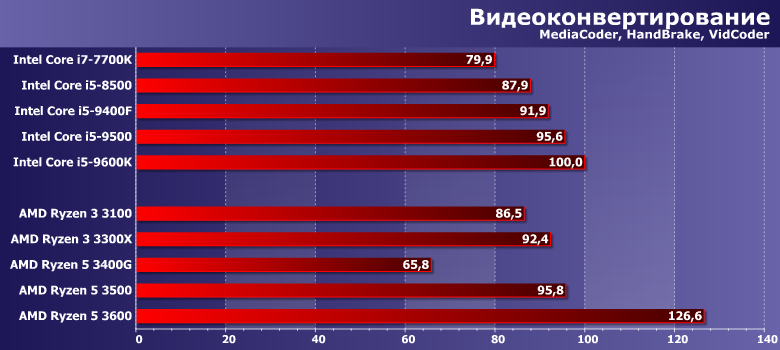
Hereinafter, the Ryzen 5 3400G will remain the whipping boy – precisely because the cores are different. How this will have to be explained to customers is not our problem. Although it would be interesting to see, of course – especially looking at the Ryzen 3 3100, which under such a load would already be enough for the role of the best quad-core processor (at least until the release of the new Core i3). It is also clearly visible that 4C/8T really roughly corresponds to 6C/6T, and this applies not only to competition within processor lines of one manufacturer (if it suddenly happens), but also to intercompany ones. Therefore, updating the assortment of Intel processors (even if small, but with price correction) is long overdue. AMD is doing well in the current realities. How it will change in a month – then we’ll see.
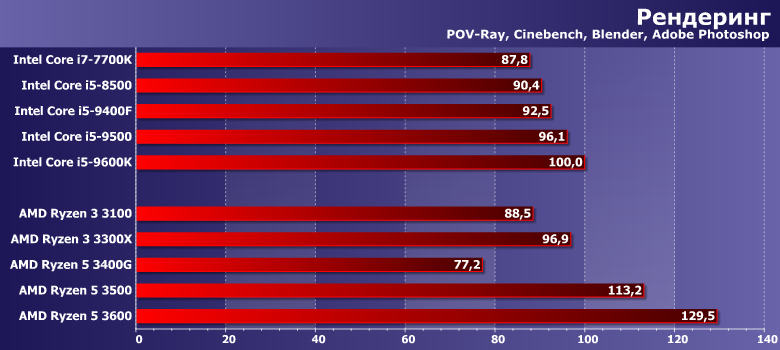
Changing the nature of the load in general is more in favor of Ryzen. But there are nuances – after all, in this case, “physical” cores are better than “virtual” ones. If they are about the same, of course, against the background of the Core i5, the new Ryzen 3 began to look even better, but even the Ryzen 5 3500, which was badly mutilated during the development process, is still faster. And the 3400G once again shows us that the improvements in Zen2 are first of all intensive – not extensive.
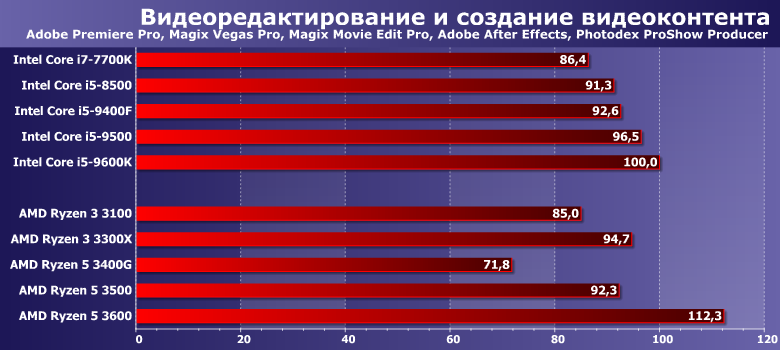
At this level, qualitative characteristics prevail over quantitative ones. Optimization for Core is better here – largely because Intel’s architecture itself is still older, but programmers still need to correctly implement all the potential features of Ryzen (especially the latest series). But in general, the most interesting results are demonstrated by the Ryzen 3 3300X (almost “monolithic” quad-core design and high frequencies) and the recently hit Ryzen 5 3600 (noticeably superior to the bulk of the contestants).
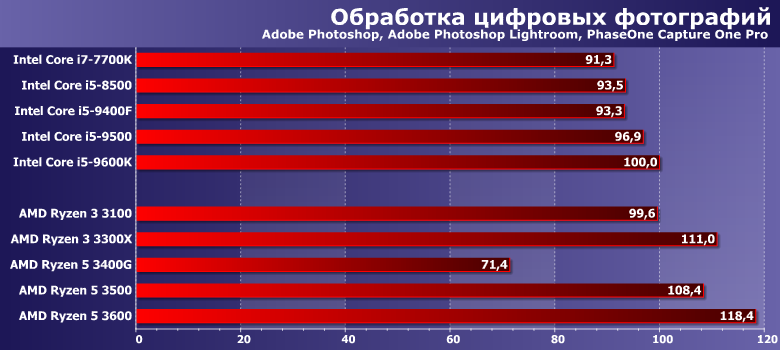
First of all, these programs vote for single-threaded performance. When Core had an advantage in this, Intel dominated: many cores were not needed, but the ratio of their performance … It is worth comparing the Core i7-7700K of 2017 and the Ryzen 5 3400G of 2019. Well – even if the microarchitecture here is actually from 2018 and does not differ much from 2017 – Intel still has Skylake with modifications, but originally 2015. For several years, AMD could not reach this level. Last year, I did it. And this immediately played a cruel joke with Intel – in fact, only the Core i5-9600K and older in performance can somehow compete with at least the Ryzen 3 3100. Recall – the younger model of the line with a recommended price of $99.
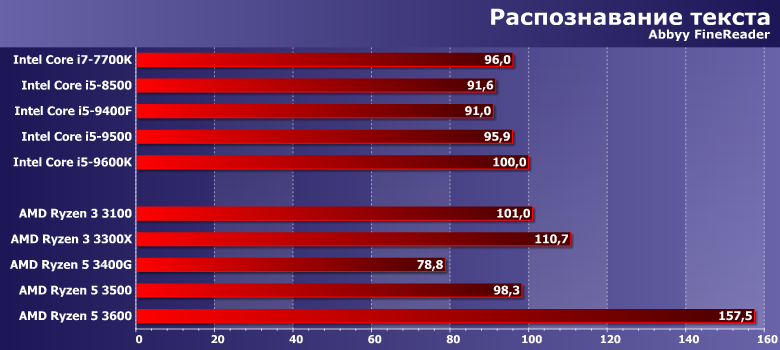
The code is simple, but easy to parallel, so it “loves” any streams and a large and fast cache. And this is the Ryzen 5 3600 in the first place. Then – the new Ryzen 3; especially the 3300X for obvious reasons. Behind them is everyone else.
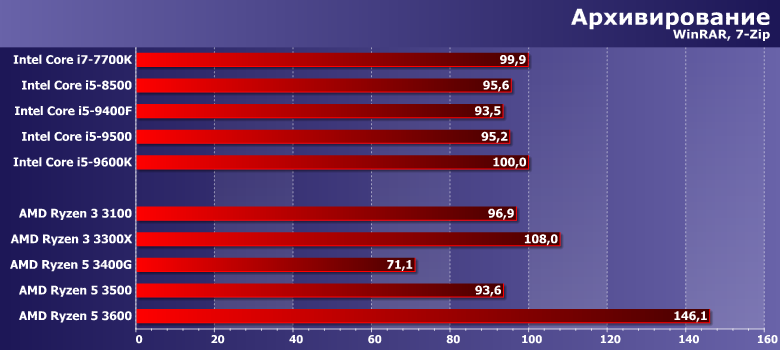
Once again, we are not surprised by the results of the Ryzen 5 3600 – this is a higher-class processor than other subjects. Intel recently sold similar models under the Core i7 brand and these will be the new Core i5s – but the current i5, as well as the “very old” i7, is no easier. We also leave the results of the Ryzen 5 3400G without comment – that’s how, unfortunately, it all worked a year ago. But the new Ryzen 3 is certainly in its place – which even managed to overtake the Ryzen 5 3500. Not for the first time already – why we said above that this pair of company models was actually needed only as a temporary solution. However, its prime cost is most likely comparable to the 3100, and may even be lower than that of the 3300X – so there is a possibility of a “global legalization” of the 3500/3500X. But if this does not happen, there is no point in getting upset. Yes, and chasing such models, in general, is usually already the same.

Moreover, even in this group (more loyal to physical cores) there are no advantages of a “stripped down six-core” one. But the new Ryzen 3 is traditionally good, because it competes well with the current Core i5 – and is unlikely to look bad against the background of the new Core i3. And you can reach a higher level, perhaps with the Ryzen 5 3600 – but that’s a completely different story.

The first and main conclusion – regardless of whether someone needs quad-core processors right now or not, but the best such models on the market are no longer Intel Core i7 of the old series, but the new Ryzen 3. It is clear that the 3100 only slightly outperformed the 7700K – so the last one is the best. Some Core i7-3770K is one and a half times slower. And here what we wrote about at the beginning can already happen – the temptation to upgrade will overtake even persistent LGA1155 users. Because it is inexpensive (relatively), fast, modern – and then the processor can be changed if necessary. Again, this is no worse than many six-core processors. And not only Intel – you can forget, for example, Ryzen 5 2600 (although in general this is the topic of one of the future materials, so let’s not rush to reveal all the cards). Yes – for the most demanding users, this level of performance is already “boring”. But if suddenly someone is concerned about the question: what is the best thing to buy dollars for 100-150? There is one answer to it. The second one will probably appear soon. But there is definitely one 🙂
Energy consumption and energy efficiency

That is why above we unambiguously attributed the tested instance of the Core i5-9500 to the Coffee Lake Refresh family, despite official data – the power consumption of the “eighth” generation is similar to the “seventh”, but the “real ninth” is much more voracious. However, the new Ryzen 3 does not have to blush against this background – they just correspond to the old Intel models, which were better than the newer ones in this regard. The power consumption of the “older” configurations is higher – although it also corresponds approximately to the latest Core i5 for LGA1151.
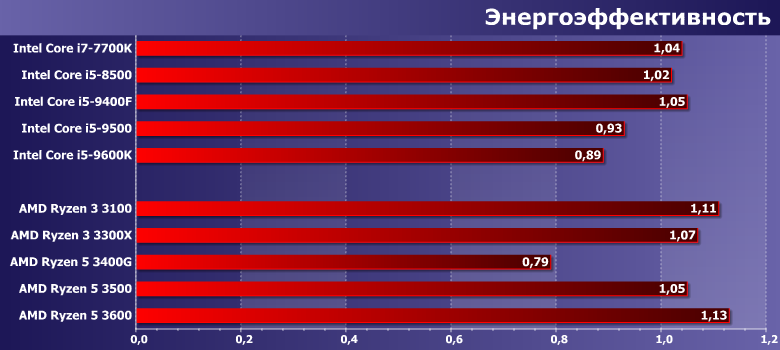
But at higher performance – so the energy efficiency of modern Ryzen is commendable. Something here, of course, and Intel helped – but the result is important. But, we emphasize – modern Ryzen, because, for example, Ryzen 5 3400G … Okay – let’s not talk about sad things. Let’s better dream that new APUs will appear soon – and a bunch of the problems shown above will be fixed. And below, too.
Games
As already mentioned in the description of the methodology, it makes no sense to keep the “classic approach” to testing gaming performance – since video cards have long been determining not only it, but also significantly affect the cost of the system, you need to “dance” exclusively from them. And from the games themselves – too: in modern conditions, fixing a game set for a long time does not make sense, since literally everything can change with the next update. But we will carry out a brief test in (albeit) relatively synthetic conditions – using a couple of games in the “processor-dependent” mode.
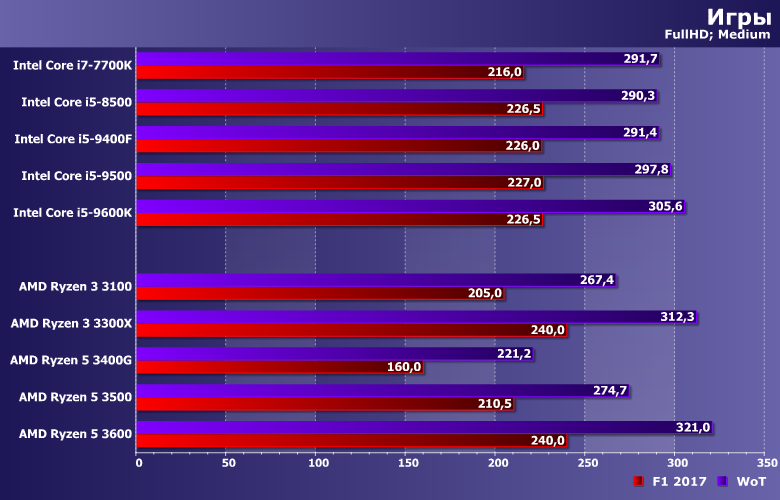
Intel processors form a fairly dense group – as expected. But AMD products are very different. The Ryzen 3 3300X and Ryzen 5 3600 perform best – which even outperform the Core i5. The monolithic design clearly helps the first here – this is how a single CCX works: no worse than adults. The Ryzen 3 3100 and Ryzen 5 3500 are not bad, but much slower – in many ways, the price of a “split” L3 is relatively small (for a family) volume. Well, the old Ryzen is better to forget and not remember. It is clear that in conditions close to reality, everything will “rest” on the video card – but this is the only thing that saves them. And the new models behave perfectly even in such an uncomfortable position. Then you can already begin to catch minor differences in specific applications with top-end video cards (buyers of which, however, in reality, are unlikely to buy them paired with a hundred-dollar processor) – but this is a separate issue. Yes, and not alone.
Total
Formally, at the moment, AMD is positioning the Ryzen 3 3100 as a competitor to the Core i3-9100F, and the Ryzen 3 3300X is against the Core i5-9400F. In fact, as you might expect, both can take on the Core i5. Till. Since the moment for the announcement was very well chosen – a couple of weeks before the update of the Intel assortment. In retail chains, most likely, we will talk about the direct competition of the new Ryzen 3 with the Core i3-10100 and i3-10300 – and this will certainly work out well for them, since AMD, just in case, left a stock at a recommended price of $ 20, which in this segment matters. Another question is that this “segment” itself, from the point of view of many buyers, is no longer interesting: when buying [one] computer, it really doesn’t make much difference whether to spend $100, $150, or even $200 on a processor. completely different processors are sold for 200 🙂 However, if we are talking only about multimedia applications or games there, saving is a good thing. There is an opportunity to do this, and without any special losses, while maintaining support for modern interfaces and having a reserve of modernization for the future in which case . It seems to us that manufacturers of finished systems will greet new processors all the more warmly: the old advertisement about four cores, four gigabytes, a gaming video card still finds a response. That’s fine.
What AMD definitely needs to do is clean up the APUs. The first models “did not get” free numbers, so the idea of assigning them to the 2000 line went well. Moreover, there were no special differences between the two generations. However, the new family is a different matter, so “numbering” the Ryzen 3200G and Ryzen 5 3400G this way was initially a dubious undertaking. And after the release of the new Ryzen 3, making a patty out of individual Ryzen 5, an even more different definition suggests itself for this action. Since the main problems have been solved, it’s time to deal with this issue.




